Episema over Several Notes in the Solesmes Method
-
In Sunday's Communion, there is a pes subtripunctis resupinus (in the Vatican/Solesmes editions, but actually a torculus subbipunctis resupinus in the manuscripts) with a horizontal episema:
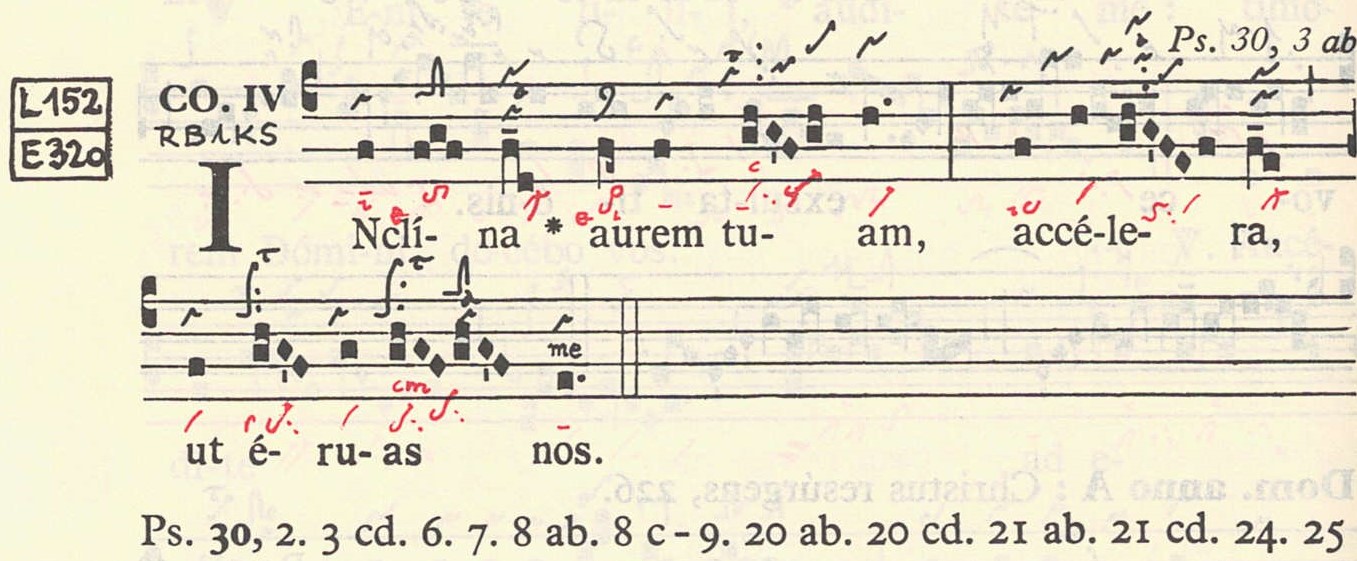 The same figure occurs in the introit Laetare at satiemini, and in Cogitationes, which is borrowed from it, at eorum. The first three notes are long in all of the notations, yet I hear scholas that claim to use the Solesmes interpretation sing it long-long-short, long-short-short (you can hear this in the recording from Triors), short-long-long, or even short-long-short! The modern notation Liber also has all three notes marked long:
The same figure occurs in the introit Laetare at satiemini, and in Cogitationes, which is borrowed from it, at eorum. The first three notes are long in all of the notations, yet I hear scholas that claim to use the Solesmes interpretation sing it long-long-short, long-short-short (you can hear this in the recording from Triors), short-long-long, or even short-long-short! The modern notation Liber also has all three notes marked long: I know there's some wiggle room for interpretation, but I can't see justification for anything except three longs here. For a Solesmes-style interpretation, I hold them about 1.5 length, not double. Does any Solesmes method authority (Mocquereau, Gajard, Suñol, Carroll, Ward, etc.) advocate the long-long-short or long-short-short interpretation?
I know there's some wiggle room for interpretation, but I can't see justification for anything except three longs here. For a Solesmes-style interpretation, I hold them about 1.5 length, not double. Does any Solesmes method authority (Mocquereau, Gajard, Suñol, Carroll, Ward, etc.) advocate the long-long-short or long-short-short interpretation?
(Sorry, I accidentally clicked the "Post Discussion" button when I meant to hit "Attach a file"!)
 Co Inclina.jpg1357 x 561 - 194K
Co Inclina.jpg1357 x 561 - 194K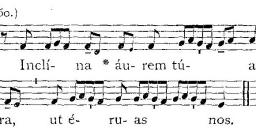
 Co Inclina MN.jpg928 x 290 - 114KThanked by 1tomjaw
Co Inclina MN.jpg928 x 290 - 114KThanked by 1tomjaw -
This is how Anton Stingl notates the communio. Alberto Turco (Liber Gradualis I) has the same. Remarkably, the Graduale Novum copies the Vatican edition.
Stingl and Turco see a torculus subbipunctis resupinus with episema, as you do. I would sing the the torculus a little elongated, with the middle note slightly longer.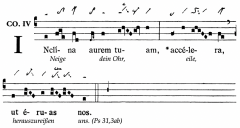
 Schermafbeelding 2022-07-26 om 19.50.25.png854 x 456 - 190KThanked by 1tomjaw
Schermafbeelding 2022-07-26 om 19.50.25.png854 x 456 - 190KThanked by 1tomjaw -
Madorganist,
I've read (and don't have in front of me) an interpretation that the episema-ed notes should not be the same length as each other, with the amount of lengthening diminishing with each added note. So, a three-note episema has long, not quite so long, barely lengthened. Others take the position you have (which makes sense) that three elongated notes means three elongated notes.Thanked by 1madorganist -
from Richard Rice:
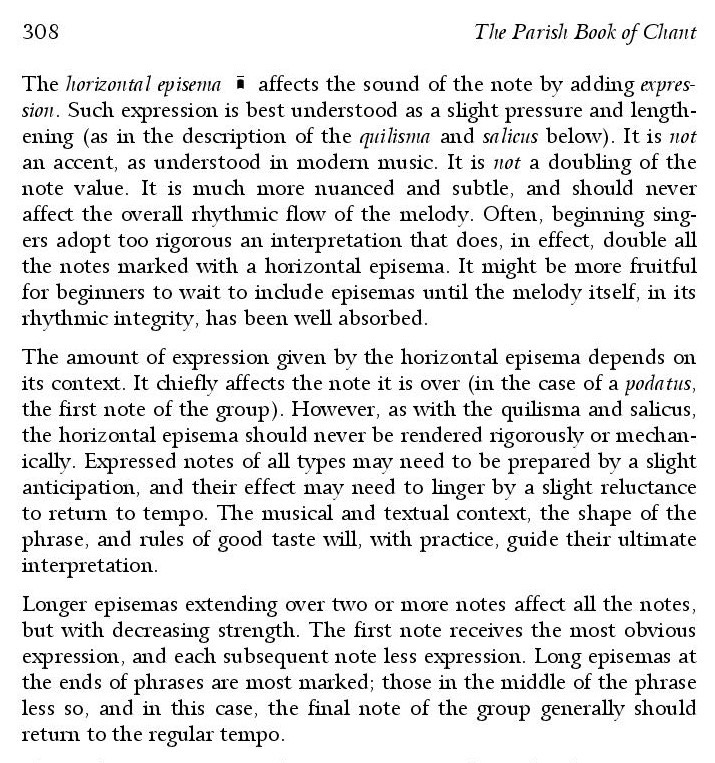 Yet the recordings from Triors sound to me like a lengthening only of the first note, the normal short value already regained on the second:
Yet the recordings from Triors sound to me like a lengthening only of the first note, the normal short value already regained on the second:
https://archive.ccwatershed.org/video/10444246/
and
https://archive.ccwatershed.org/video/12859696/
Do others hear it that way as well?
 PBC Episema.jpg715 x 763 - 268KThanked by 1FSSPmusic
PBC Episema.jpg715 x 763 - 268KThanked by 1FSSPmusic -
I shall record in the annals of history that my memory failed me only about the source, which I could not remember, and not the details at issue.
Thanks. -
"Accelera" suggests hastening on the unmarked notes; perhaps 'poco rubato' is a better gloss than the 'poco ritenuto' that I usually think to myself.
-
Richard,
Would that be an example of "word painting", you're advocating? At some level, is this kind of rubato not a bug, but a feature of chant? (Put the question a different way, is isorhythmic chant, at least in some cases, oxymoronic because unmusical?) -
Long-long-short or long-shorter-shortest is one way that is more and more common; Fontgombault's recordings for the Laus in ecclesiae course are aggressive on this point.
In fact, the Schola Saint-Grégoire manual for the course (as edited by Triors and taught by the SSG in France and Clear Creek, in the US for English speakers) talks about this with respect to the torculus's interpretation in lesson 11. (I'm paraphrasing, since I have the book in French.) : The beautiful, light, curve of the voice pushes on the first note and is rounded and legato on the second and third. It is light, delicate, and soft. The danger is in not sufficiently rounding the second note or to push too hard on the last one… the torculus which pushes forward is in the middle of the melodic development, driving towards what follows. There is a strong push on the entire neume; all three notes are lengthened and there is a progressive crescendo… The torculus of cadence is at the end of a [phrase], and is naturally lengthened but especially on the first note. The other two are lighter and there is a decrescendo that benefice from the breadth of the last note.
I'm actually very much of a fan of the recordings from Triors, and without wanting to skip Fontgombault, I'm most interested in visiting Triors due to this way of singing being made popular thanks to that abbey. -
As far as I can tell, Dom Gajard's recordings are considered the gold standard for the pre-Vatican II Solesmes method. I hear long-short-short here too:
https://www.youtube.com/watch?v=XU38VNCZzI0
I guess Solesmes ignores not only some of the episemata of the manuscripts but even their own editions! -
I noticed that this figure occurs in this coming Sunday's Communion too, at quoniam. The Triors recording has the same interpretation as the other instances: first note long, the rest short. Is there other written support for this rendition besides what Matthew cited? Or is it simply a case of imitating Gajard's recordings? I don't understand what is meant by "The danger is in not sufficiently rounding the second note." What does it mean to "round" the note? What is the exact terminology of the English edition?
-
You may be able to get to figure out what they mean if you register on the Laus in ecclesia website. Fr Bachmann has filmed the lessons — it is very much in the style of Clear Creek, so take that for what it’s worth. If you register, you’ll have access to the videos, available for free but through the course website, as they are unlisted on Youtube. This kind of question is what Fr Bachmann and his confrères are for, IMHO, so I’d actually be curious to see if they had an answer based on the evidence of past performance coupled with the books. (If I had the English book or knew someone who did, I’d get the info for you.)Thanked by 1madorganist
-
To complicate matters further, there is another form of this same figure transcribed in the modern notation Liber with a short first note:

In Gregorian notation, the episema in the Communion example above starts about half a note's width before the neume, but in the responsory Tenebrae, it is flush with the note itself: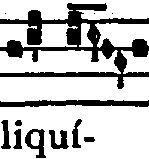
Interesting. I'll be on the lookout for more of these.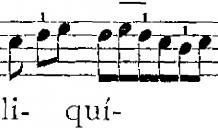
 liquisti MN.jpg455 x 267 - 53K
liquisti MN.jpg455 x 267 - 53K
 liquisti GN.jpg149 x 159 - 33K
liquisti GN.jpg149 x 159 - 33K -
I love comparing different settings of the same chant, the differences are almost endless, and show no logical pattern.Thanked by 1ServiamScores
-
I'm not an expert, but with things like this, I wonder if the differences are simply typographical imprecisions (I hesitate to call them typos per se, though the modern notation example might be one) or if the monks changed their minds; you occasionally find that they changed the notation over the years.Thanked by 1tomjaw
-
Last night, I found a strange new wrinkle on this question.
An episema over several notes is relatively common. In last night's Magnificat antiphon, on the word "luna" there appear to be two episemas on the same note.
Hmmm. Thoughts?Thanked by 1madorganist -
I identified more than 20 examples of the episematic pes subpunctis in the Liber and will compare the modern notation edition for each of them and report back. As far as I can tell, the double horizontal episema below and above a pes only occurs in the chants for the Office, never the Mass. Solesmes apparently had slightly different editorial principles for the different liturgical books. Another example that comes to mind is a bivirga with horizontal episema over both notes, which exists in the responsories but, as far as I know, never in the Proper of the Mass, and they apparently intend by it the same rendition as an ordinary unison tristropha.
-
You must have spare time today!
Might I borrow some? -
Results: Every example from the Mass begins with three long notes in the modern notation edition. If the episema is positioned slightly to the left of the first note, the lower note is invariably long. If the episema is flush with the note, there seems to be no correlation with whether the lower note is short or long. There are a few other examples from the Matins responsories with a double episema. It is the clearest of the notations; it's unfortunate that it isn't used more consistently.Thanked by 1tomjaw
-
I’ll just posit this here and others can take it or leave it:
I think there are MANY acceptable interpretations of chant. Remember these markings are from Solesmes and the Vatican edition doesn’t even include them. Every week, for the needs of my psalm composition project (I’m creating an annual cycle of psalms based on ancient Gregorian melodies) I trawl the cantus database and look at oodles of scans of ancient manuscripts of the same texts. One thing that I’ve noticed is an apparent contradiction: there are remarkable similarities between manuscripts across time and place (indicating a similar genesis, much the same way as modern romantic languages share a common core), and yet there are lots of little variations as well (think Spanish’s ‘taza’ vs. French’s ‘tasse’).
These variations (whether intentional or unintentional) would have been lived and breathed for centuries in their various locales. I can only imagine that these little foibles are beautiful to our Lord, who created as many varied souls as stars in the sky. He is worshipped in innumerable churches, all decorated differently, with priests wearing different vestments, and different people in the pews, and different organs in the lofts… different, yet the same.
Consequently, while I certainly understand the value and desire for common melodies and interpretation, it also strikes me as a bit overly sterile and a farcical concept only embraced by modern scholars. It’s OK if every church doesn’t sing EVERY chant EXACTLY the same to exactly the same melodies. -
Of course, but whoever edited the Solesmes edition meant a certain thing when he added a horizontal episema to a group of notes. The modern notation version was edited by someone from the same monastic community, who presumably meant the same thing when he added the episema to a group of eighth notes. Exactly what they meant is the point of this thread. Discussion of the Solesmes method should not be taken either as an unqualified endorsement of that method or a disparagement of other approaches, let alone an attack against diversity of interpretations.
-
I see that this discussion is being rehashed in another thread. I just listened to the recordings from Triors and Solesmes again. In each example, I hear a long note followed by four shorts, with no perceptible lengthening of the second or third notes. It is sung as if the episema were only written over the first note. What am I missing?Thanked by 1FSSPmusic
-
Humor sidebar: Emo Philips should update his classic routine to reflect differences in chant interpretation:
https://www.youtube.com/watch?v=l3fAcxcxoZ8 -
Madorganist, definitely write to Fr Bachmann who can likely get you scans of the relevant passages from Laus in ecclesia. Depending on the passage, you’re not missing anything.Thanked by 1madorganist
Welcome to the MusicaSacra Forum!
To participate in the discussions on Catholic church music, sign in or register as a forum member, The forum is a project of the Church Music Association of America.
Categories
- All Discussions21,142
- General Music Discussion8,229
- Job Openings201
- Management of Music Programs850
- Choral Matters533
- Church Documents and Rubrics525
- CMAA Notes302
- Events719
- For Newcomers: Read First26
- Sacred Polyphony547
- Hymnody872
- Gregorian Chant: General2,702
- ↳ Graduale Romanum and Liber Usualis368
- ↳ Graduale Simplex60
- ↳ Semiology63
- Vernacular Plainsong696
- Anglican Use and Anglican Chant68
- Organ, Other Instruments and Repertoire435
- New Composition/Works in Progress1,294
- Recordings234
- Music for Hispanic Ministry159
- Music Education: Children211
- Music Education: General222
- News Items245
- Positions Wanted2
- General Discussion: Catholicism739
- Amusements177
- General Discussion1,035
- Opinions119


